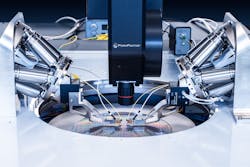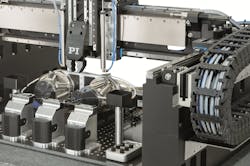Precision and motion tools: Meet Markus Spanner, CEO of Physik Instrumente
Physik Instrumente (PI) is a privately held company that designs and manufactures world-class precision motion and automation systems including air bearings, hexapods, and piezo drives at locations in North America, Europe, and Asia. Founded five decades ago, the company now employs more than 1400 people worldwide.
In this interview, Jose Pozo, Optica’s CTO, talks to CEO Markus Spanner about his experience taking over his father’s company and leading it through a global pandemic. This discussion reveals Spanner’s thoughts about entrepreneurship, company culture, and the future of the manufacturing industry.
Early career
Spanner’s career started at Bond University in Australia, located on the Gold Coast, close to Surfers Paradise. Spanner jokes that if you put those two descriptors together, you might think “there’s nothing but happy life, enjoyment, and no studies.” But Spanner did, in fact, study and earned a master’s degree in International Business.
Spanner views the most valuable aspect of his education as being located in a “melting pot” of cultural differences. This region of Australia, and especially the University, attracts people from all over the globe. His time at Bond University involved more than learning the knowledge of business administration or international business.
He was well acquainted with multiculturalism before his time at Bond University and made it his focus long after. Spanner spent his formative years of high school in the United States, before venturing to Australia for three years.
Spanner was also inspired to visit Japan, where he spent a year immersing himself in the culture and learning the language. During his early career at PI as Managing Director CFO, he spent less than half of the year in the office. Instead, he traveled to different countries, where he attended conferences/exhibitions and met with potential customers.
Family ties
PI was founded in 1970, making it older than most of the technologies found within the optics and photonics industry today. In 1977, Spanner’s father Karl had just finished his Ph.D. and started his first job at the company. On his first day of work, Karl Spanner rang the doorbell and was greeted by a woman who asked: “Mr. Spanner, do you want to hear the bad or the good news first?”
Markus Spanner’s father replied: “Let’s go with the bad first.” The woman said: “My husband died of a heart attack at the tennis court just a week ago. The good news is you are the only employee. Enjoy, take care of the company, and have fun!”
In the beginning, there was a period of hardship—Karl was flung into a company he knew little about. It took time for him to familiarize himself with the topic, events, customers, and industry—products and applications were completely different back then.
But Karl Spanner led PI for 43 years, until 2020. He transformed his company and its products during this time. PI is now a market leader in precision motion control, nanopositioning, and motion tools worldwide (see photos). It’s an enabler of most of the high-precision automation for manufacturing from medical to automotive, from space to biotech.To set the stage, 2007 was a few years after the telecom bubble burst and the entire optics and photonics industry was in recovery mode. The industry was seeing new opportunities in next-generation sensor technologies. When Markus Spanner joined PI in 2007, the biggest market for the company was semiconductors, making it the company’s main focus. But this made the company vulnerable to the cyclical nature of the semiconductor industry.
Later, PI branched out into different markets and applications to blunt the effects of booms and busts of the semiconductor market, a sector dictated by international relations and manufacturing trends. PI expanded into microscopy, life sciences, and photonics applications, which has helped the company thrive, no longer depending on a single application or market to dictate their success.
During the past 15 years, what were your defining moments at PI?
In 2008/2009, during the financial crisis, PI took an unusual step to not lay off any employees. In the face of a worldwide economic collapse, when other companies were letting go of employees to cut costs, PI kept all of its employees—a show of strength and leadership in a time of uncertainty. Even 14 years later, employees remain grateful and engaged—this decision made an impact on the professional and personal development of Spanner as he has transitioned from employee to leader.
In 2017/2018, PI decided to change its organizational structure to reflect the rapidly changing environment of the optics and photonics industry. By changing the company structurally, PI was also able to shift employee culture and implement new processes to meet industry demands and satisfy customers.
On January 1st, 2020, Markus Spanner took over the CEO position from his father. But the feeling of excitement and pride was short-lived: 20 days after taking over the company, the COVID-19 virus was beginning to take the world by storm. By April, he was running a company as a new CEO during a full-blown pandemic. Spanner had to help his company navigate not only through a big company-wide transition but also through a global health crisis—and he did so with empathy and strong leadership.
The common denominator of these three milestones is the appreciation and the respect the company, PI, has for its employees. PI has a wall of full of stars representing employees that have been with the company for more than 20 years.
How is software shaping the future of PI?
Historically, PI focused on providing hardware solutions in automation and precision technologies. In recent years, however, the company shifted its focus to providing software solutions for customers to automate and reconfigure tools—a recommendation by Spanner’s CSO, Stephan Bussa. His philosophy of “software will sell the hardware” inspired Spanner to expand the company’s portfolio and customer base. These investments are also enabling customers to be co-developers of PI’s tools.
How is PI dealing with supply chain disruptions?
Everyone is affected by supply chain disruptions. Spanner notes that the supply chain issue is more widespread in nature—it isn’t solely due to a singular missing component. The company is seeing a huge rise in demand, which means testing and measurement equipment must be secure and in place to get products out to customers. Solutions providers need “space, people, and investments,” he says. In the past two years, Spanner has focused on building up all of these aspects of the company, including forming an international supply chain team dedicated to finding second and third sources for their suppliers.
Is sustainability a part of PI’s strategy moving forward?
PI is contributing to a sustainable future in both direct and indirect ways. One big part of PI’s strategy is photonics. Spanner points out that many of the industries today consume so much energy to maintain, run, and cool systems, but photonics can revolutionize it.” These efforts are more indirect because photonics technologies tend to propel and support an industry toward sustainability.
PI is becoming more involved in the medical industry
PI has been interested in the medical industry for decades, but the market only recently started booming due to the COVID-19 pandemic. Increasing demand for medical technologies and applications, such as testing, hospital equipment, and medical devices, is enabling photonics companies, including PI, to enter these emerging markets and expand their service and product portfolios.
Spanner is thinking bigger than just COVID-19 testing—once in the door, the possibilities are endless for testing. Quick examples include blood testing and home health monitoring.
PI is also prepared to meet the rising demand of the hospital equipment market—operations, such as surgery, are becoming more precise. Hospitals will require tools and software to carry out these sophisticated procedures, so PI and similar photonics companies want to provide precision solutions and applications in this emerging market.
The medical industry is a booming market and PI has the technologies and the infrastructure to meet customer and supplier demand.
How will PI be an enabler of 3D printing for the future?
Spanner says 3D printing is far more advanced in other industries than in optics and photonics. He views it as something that will help their customers adopt faster and more customized solutions. “This is a trend our industry must absolutely follow,” he adds.
Spanner is thinking big for the future of 3D printing, a future where the medical and 3D printing industries collaborate on precision solutions, such as the manufacturing of 3D-printed body parts. 3D printing has come a long way in the past five years—imagine what could be possible in the next five years.
What is PI’s mission?
PI’s mission is to “solve problems of the future, to challenge and enable customers to make technologies and solutions in their field for the future,” Spanner says. His vision is for PI to enable customers to push the boundaries in technological development to create a brighter future.
His personal dream is to “ensure the company is in a position to change all the time,” Spanner says. “The world is changing rapidly. If PI is forced to stop to change or adjust, then it will no longer be competitive.”
Spanner promotes a “constantly questioning” philosophy to be a market leader. “This is fundamental to continue to grow and have happy, satisfied customers,” he says. “My dream is that in 15 years we will have a company that is very different than it is today. 15 years is quite far out—many new things will be implemented by then, which means the company will look different.”
Words of wisdom for younger generations?
Spanner says he hopes the younger generations will be “strong and ambitious to make decisions, take risks, and to be entrepreneurial. You cannot always win, but you can get back up again if you fail one or two times. I hope the younger generations will possess this power of resiliency.”
About the Author
Jose Pozo
Chief Technology Officer, Optica
Jose Pozo joined Optica in March 2022, and has spent more than 25 years working in photonics. He earned a PhD in quantum physics from the University of Bristol (U.K.), and an M.Sc. and B.Eng. in telecom engineering from UPNA, Spain / VUB (Belgium). Prior to joining the European Photonics Industry Consortium (EPIC) in 2015 as CTO, Jose was a Senior Photonics Technology Consultant with PNO Consultants, with some of the main accounts such as CERN, Thales, and TE Connectivity. He has worked at TNO, The Netherlands Organization for Applied Scientific Research, and as a postdoctoral researcher at the Eindhoven University of Technology in the Netherlands, where he contributed to the early development of EFFECT Photonics.
Ana Fowler
Market Research Analyst and Coordinator, Optica
Ana Fowler is market research analyst and coordinator at Optica (Washington, DC).


